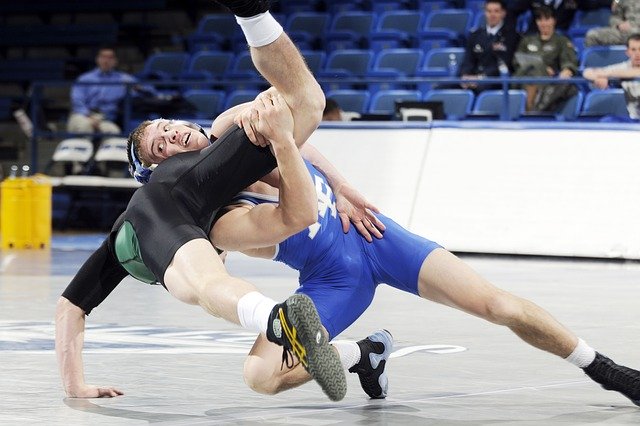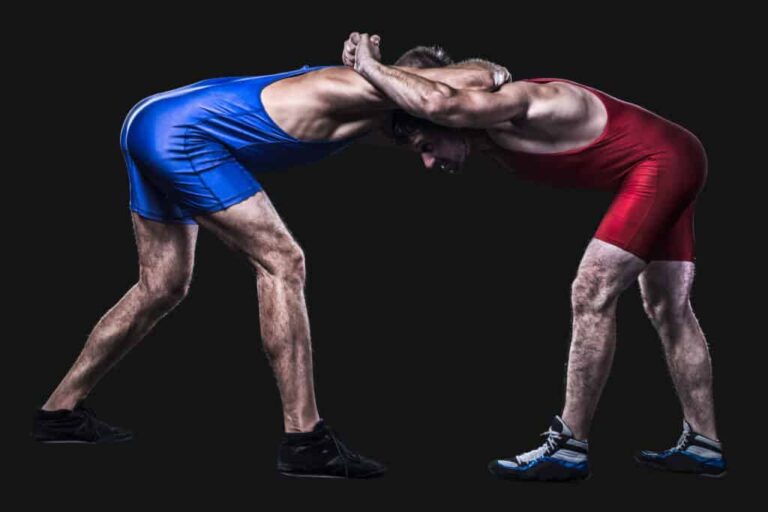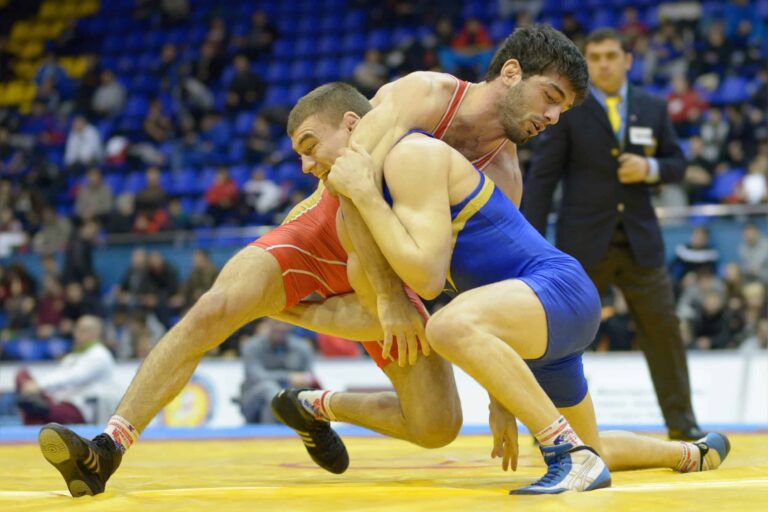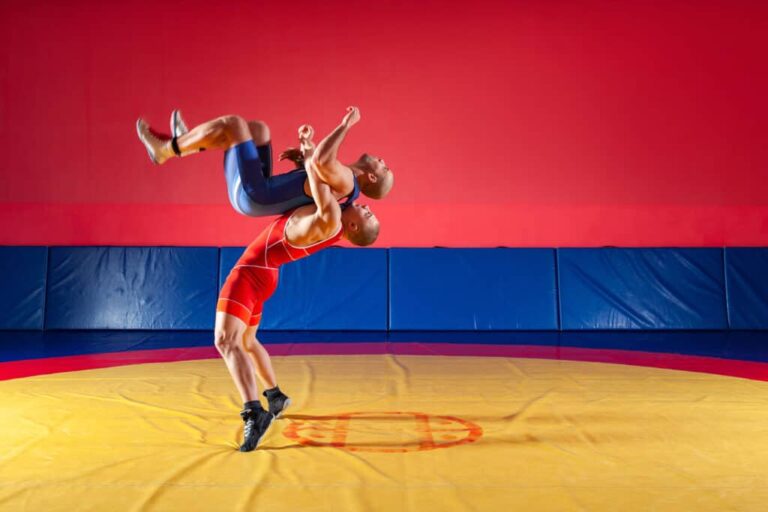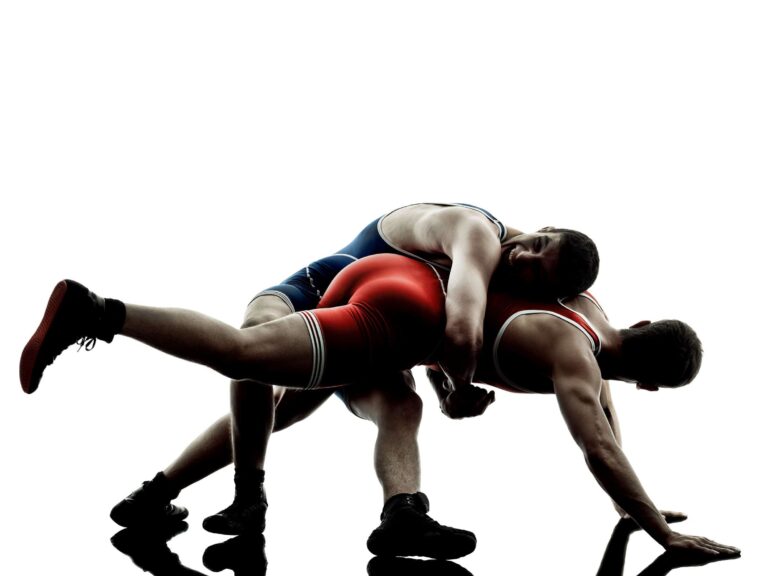Freestyle Wrestling: Everything You Need To Get Started
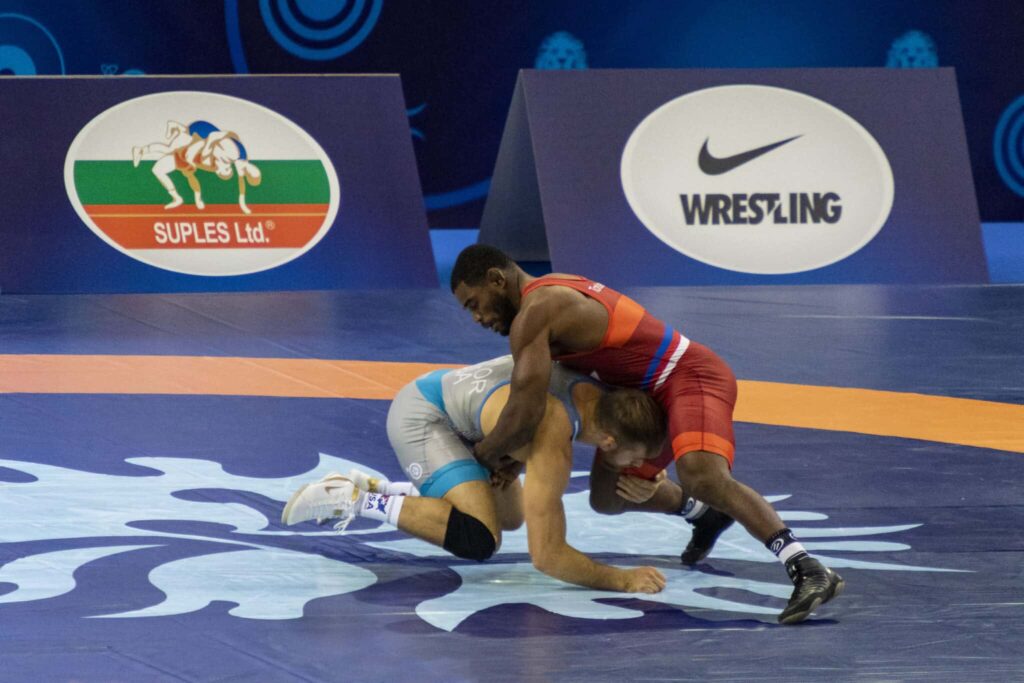
As one of the oldest sports in the world, wrestling is still popular everywhere. Freestyle wrestling is one of the widely-popular amateur sports featured in the Olympic Games and World Championships. So, what’s freestyle wrestling, and what are its rules and scoring system?
Freestyle wrestling is one of the two wrestling disciplines at the Olympic Games. Its objective is to pin the opponent’s shoulder to the mat for a specific number of seconds. You can also score points with takedowns, reversals, and escapes.
In the rest of this article, we’ll give you a comprehensive guide to freestyle wrestling. We’ll explain the rules, the scoring system, penalties, and weight categories. We’ll also talk about some of the most popular moves in freestyle wrestling.
What Is Freestyle Wrestling?
Freestyle wrestling is one of the two main branches of wrestling that are part of the Summer Olympics—the other being Greco-Roman. It’s been a constant element of the Games since 1920.
This combat sport brings together elements from multiple sports, such as judo, sambo, and traditional wrestling. Its origins can go back to ancient France, almost 5,000 years ago.
Some of the moves that were popular in Egypt and Babylon are still part of the game. However, ancient Greece is credited with coming up with the sport that became modern-day wrestling.
Although men have primarily dominated the sport, women have competed in the freestyle wrestling Olympics since 2004.
The international rules allow for fair holds, throws, or trips that don’t endanger the opponent’s life or limbs. Athletes can hold opponents below the waist and attack and defend using their legs. However, kicking, grabbing the uniform, punching, or hitting with the head isn’t legal.
Freestyle wrestling is similar to Greco-Roman, but they have some differences. Generally speaking, anything goes in freestyle, but there are more limitations in Greco-Roman. For example, in Greco-Roman, athletes can’t use their legs. In fact, in freestyle, athletes can use all their body in attacking and defense.
Another difference between the two disciplines is in the way opponents throw each other to the ground. In Greco-Roman, the takedown doesn’t count if the wrestler doesn’t maintain contact throughout the takedown.
However, in freestyle, the athlete can lose contact with the opponent to find a better position. Athletes compete with other athletes who are about the same weight. That’s why they’re divided into multiple weight groups.
Freestyle Wrestling Weight Classes and Age Categories
Women
There are four age categories for women: schoolgirls, cadets, juniors, and seniors. Girls can start competing in wrestling matches when they turn 14 and move up a class every two years until they become seniors at 20.
There are ten weight classes for the two lower categories, starting at 28 kg (62 lb) for schoolgirls and 36 kg (79 lb) for cadets. Juniors and seniors have eight and seven weight classes, respectively.
Men
Men compete in five age categories. The age groups are similar to women, but men have an additional class for veterans older than 35.
The number of weight classes is also the same as those of women. And veterans compete in the same classes as seniors. However, the weight ranges are adjusted based on the physical differences between male and female wrestlers.
Both men and women who are a year below the minimum age in each group can compete in that group with parental permission and a medical certificate. For example, a 17-year-old boy who would typically compete as a cadet can enter the juniors class if his parents and physician allow it.
Freestyle Wrestling Mat
Wrestling mats are made of materials like rubber or foam that absorb shocks to create a safe space for wrestling and minimize impacts and injuries.
Each part of the mat has a specific purpose. Here’s a brief description:
- Central Circle – There’s a circle 1m (3′ 3″) in diameter in the middle of the mat. This area is where the two opponents stand against each other at the beginning of the game.
- Wrestling Area – This area is surrounded by a circle 7m (23′) in diameter. The bout takes place in this area.
- Passivity Zone (Red Zone) – It’s a red stripe around the wrestling zone, which is one meter wide. It indicates passivity.
- Protection Area – After the passivity zone, there is the protection area, which is 1.5 m (4.9′) wide. The wrestlers can’t enter this area, and if they can push their opponent to this zone, they can get points.
The mat has two diagonal corners marked blue and red, indicating the wrestlers’ singlet colors. The coaches stand on the same side of the mat as the athletes.
According to the United World Wrestling (formerly FILA), the mats for world cups, world championships, and the Olympics must be new. They’re placed on a platform with a maximum of 1.1 meters (3′ 7″) and a minimum of 0.50 meters high. The warm-up and training mats for Olympic Games and world championships also need to be new and FILA-approved.
The covering area surrounding the mat is a free zone and 2 meters wide. The protection has to be different in color from the mat.
Qualification and Elimination Rounds
The competitions follow a direct elimination system. The ideal number of wrestlers for such a system is 4, 8, 16, 32, etc. If there’s no such number of contestants, a qualification system will determine who gets to compete in the final round.
For example, if there are 19 wrestlers, they should reach the ideal number: 16. Three wrestlers who drew the numbers over 16 and three wrestlers with numbers below 16 will compete in three matches. Those who win will go to the elimination round.
All the wrestlers are paired off and compete during the elimination round until two wrestlers remain to fight for first and second place. The repechage round determines the bronze medalists. It involves competitions among all athletes who lost to the two finalists.
The wrestlers compete in the order of competition levels they lost to the finalists. There will be two groups of wrestlers, with each group consisting of wrestlers who lost to either finalist. Each group has a final winner. That’s why freestyle wrestling competitions have two bronze medalists.
Each weight class has to finish its competitions in one day. Physical examinations and weigh-ins take place a day before the matches. Then each wrestler randomly draws a number that determines their opponent in the first round.
Freestyle Wrestling Refereeing Body
Every match should have a refereeing body consisting of the following:
- A referee – The referee directly supervises the bout on the mat. He/she controls the match, blows whistles to mark the start, interruption, and end of the game, and makes sure the wrestlers obey all the rules.
- A judge – The judge’s place is by the mat’s side, keeps track of the scores, and helps the referee make decisions when required. The judge will signal the referee when a fall takes place and verifies it.
- A mat chairman – He/she controls the scorer’s table and works as a coordinator between the judge and the referee, settling any possible disputes. The referee must get the chairman’s verdict in passivity cases, giving caution, and before admitting a fall.
Freestyle Wrestling Rules
The United World Wrestling (UWW) governs the wrestling world and issues and frequently updates the freestyle wrestling rules.
Duration
The Olympic Games take place for seven days on three mats. For senior and junior World Championships, the duration is nine and seven days, respectively.
The duration of each bout depends on the age division. Schoolboys, cadets, and veterans compete in two 2-minute rounds with a 30-second break.
Juniors and seniors will wrestle for two 3-minute periods with 30 seconds of a break.
Freestyle Wrestling Uniforms
The uniform in freestyle wrestling is called a singlet, commonly made of spandex or Lycra. It’s a tight-fitting uniform that gives the wrestlers maximum flexibility. The opponent has minimal grip due to the material.
Each side has to wear either a blue or a red singlet to distinguish them from their opponent. The teams choose their color and design based on the colors in their country’s flag.
Before the match, the referee checks all the singlet requirements. If the singlet doesn’t comply with the rules, the wrestler will have one minute to change it. If they can’t solve the problem, they will lose the competition by forfeit.
Freestyle Wrestling Scoring System
The scoring system involves a range of 1 to 5 points. Each move receives a point depending on its difficulty level. The wrestler with the highest points at the end of the two rounds wins. However, if there’s a pin, the wrestler who made the pin immediately wins the match regardless of the scores.
Here are different moves and their respective points. But before talking about the moves, you need to understand how the positions work:
- Neutral refers to both opponents’ position when they’re facing each other and ready to start the match.
- The referee’s position is the start position, with one wrestler down on all fours and the other standing on top. The top wrestler kneels and puts their far-side arm around the other wrestler’s waist. The other arm is on the opponent’s nearside elbow.
- The top position is the wrestler in the top referee’s position. The bottom position is the opponent on their hands and knees.
The following are the moves and their respective points:
- A Reversal is when a wrestler is in the bottom position and tackles the opponent to get the top position. This move has 1 point.
- An Escape is when a wrestler is in the bottom position and changes their position to neutral without going to the top. This move has 1 point.
- A Takedown is when both wrestlers are in a neutral position, and one of them takes the other down to the ground. This move has 2 points.
- Grand amplitude is a throw where a wrestler lifts their opponent with their feet entirely off the mat. This position, where the wrestler’s back or shoulders are parallel with the mat, is called the danger position and has 5 points. Note: If the wrestler performs a grand amplitude throw, but at least one hand of the opponent touches the ground, the attacking wrestler gets 4 points.
- A Near fall is when a wrestler has their opponent’s back on the mat at a 45-degree angle or less. If it’s less than 5 seconds, the move receives 2 points. For more than 5 seconds, it gets 3 points.
It’s also possible that an athlete starts attacking, but their opponent ends up with points. If a wrestler has one foot in the protection zone, their opponent receives a point. Also, if a wrestler can’t complete a hold successfully, their opponent gets 1 point.
Fouls In Freestyle Wrestling
There are several illegal actions and holds that receive penalties. When a wrestler performs a foul, they receive a verbal warning, caution, lose points, or get disqualified, depending on the foul’s severity and repetition.
The following are some of the most common fouls in freestyle wrestling:
- Passivity is a negative tactic that involves being overly defensive. At first, the referee gives a verbal warning. If it continues, the wrestler gets a shot clock—a penalty period for 30 seconds, during which they must be active. If either wrestler receives at least 1 point during this window, the passive wrestler doesn’t get a penalty point. But if neither one scores, the inactive wrestler’s opponent gets a technical point.
- The illegal start is when a wrestler initiates before the whistle blows. A false start is when either the top or bottom wrestler isn’t in the proper position. The penalties include two warnings and 1 point subtraction if the incident repeats. This foul doesn’t lead to disqualification.
- If a wrestler requests an injury time-out, the opponent will get 1 score unless the injury involves bleeding.
- If a wrestler receives three cautions, they’ll forfeit the match.
- An Out-of-bounds foul happens when a wrestler’s foot is in the protection area. In this case, the referee will stop the match and give 1 point to the opponent.
Other forbidden actions include:
- Action that physically hurts the opponent like pulling hair, biting, pinching, or twisting fingers.
- Holds that put the opponent’s life in danger, causing their arms or legs to break or dislocate, like kicking, pushing, or strangling.
- Holding the opponent by their singlet.
- Talking during the match.
- Grasping the mat or clinging to it.
- Grasping the opponent’s foot sole.
- Interlocking the opponent’s finger to prevent them from active wrestling.
These actions are penalized by a caution, an award of 1 or 2 points to the opponent, or a forfeit.
How To Win In Freestyle Wrestling
A wrestler can win a match in a variety of ways.
Victory By Fall
A wrestling match’s primary objective is the fall. It happens when a wrestler manages to hold both shoulders of the opponent’s on the ground. The wrestler has to keep the opponent’s shoulders on the ground long enough so that the referee recognizes total control over the fall.
The duration ranges from half a second to two seconds. If the fall occurs at the edge of the mat, the shoulders must be totally in the orange zone, and the wrestler’s head can’t touch the protection area. Only under these conditions will the fall be accepted.
Victory by Technical Superiority
Win by technical superiority, which is also known as technical fall, it occurs when the difference in points reaches 10. If any wrestler achieves this difference anytime during the bout, the match will stop, and the winner is declared.
Victory by Forfeit
If a competitor doesn’t attend the match or can’t continue the competition, no matter what the reason, the opponent will be the winner by forfeit.
Victory by Injury
If an opponent can’t continue the match due to an injury or illness, the opponent will win the game. Plus, if the wrestler takes too many time-outs for injury or has uncontrollable bleeding, an injury forfeit will occur.
An injury caused by the opponent leading to the wrestler’s inability to continue will disqualify the opponent at fault. Of course, it is never your goal in freestyle wrestling to injury your opponent on purpose.
Disqualification
Disqualification occurs when a wrestler receives three cautions in a single bout. If a wrestler doesn’t perform a fair play, cheats, dopes, or exhibits brutality, they’ll be removed from the tournament.
Points
If no wrestler in the bout wins by a fall or technical superiority, the competitor with more scores in the match will win.
Popular Freestyle Wrestling Techniques
Freestyle wrestling uses a wide range of moves, holds, throws, and locks to collect points and hopefully pin the opponent’s shoulders to the ground. While there’s a vast range of freestyle wrestling moves, here are some important ones that can lead to success.
Basic Penetration Shot
Penetration shot is a move that wrestlers need before performing any takedown. It allows them to go underneath their opponent’s defense and perform their own offensive move.
It’s a pretty straightforward move that involves going down, stepping forward, and putting one knee on the ground between the opponent’s legs. When done correctly, the penetration shot allows the wrestler to perform a wide range of takedowns.
Head and Arm Throw
Throws are One of the most common freestyle moves that start with a neutral position. Head and arm throws are essential since they can gain good points.
The move involves grabbing the opponent’s triceps using one hand while the other arm goes behind the opponent’s neck. Then it rests on their neck, clapping the other hand on the triceps. The wrestler uses their outside leg to step into the opponent and twist toward them by 180 degrees. This allows the attacking wrestler to twist the opponent’s upper body down easily.
Double-Leg Takedown
It’s a basic wrestling move that effectively helps wrestlers pin their opponent. It involves attacking the opponent’s both legs simultaneously.
Before executing a double-leg takedown, the wrestler needs to have the right stance. In a deep penetration step, they put their legs between the opponent’s feet. Then, they wrap their arms around the opponent’s knees. Stepping up with the trail leg and forward momentum, the wrestler takes the opponents down to the mat.
Single-Leg Takedown
As an offensive technique, the single-leg takedown is another fundamental move that wrestlers with all skill levels use.
It needs the same stance and penetration step as the double leg takedown. The wrestler needs to keep their head up, back straight, and hips in.
The attacker wraps their arm around one of the opponent’s legs, locking behind the knee. With no space between the two athletes’ bodies, the wrestler goes back up to their feet using their trail leg and gets the opponent down on the mat.
Wrist Control
Wrist control lets the wrestler move the opponent into a position that yields points. The athlete grabs the opponent’s lead-leg wrist and moves their two hands up toward the opponent’s elbow. Then they touch the opponent’s collar with their forehead. This move gives wrestlers control over the opponent’s moves by moving them out of their positions.
High Crotch Takedown
This is another fundamental move that most wrestlers perform. It’s like the single-leg takedown, but instead of wrapping your arms around the knees, the arms go as high up as possible along the opponent’s legs. That’s where the name high crotch comes from.
Front Headlock
It’s a basic lock that’s possible with both standing position and on the mat. The opponent’s head is lower than the wrestler’s, who puts their chin on the opponent’s back and wraps their arm around his or her head. The wrestler brings their other hand through the opponent’s armpit area, locking both hands. This way, the opponent’s head and arms are locked together.
History of Freestyle Wrestling
Wrestling entered the ancient Olympic Games in 708 B.C and quickly became a significant discipline in the tournament.
Freestyle wrestling originated in Great Britain and the US. Freestyle wrestling was adapted and influenced mostly by catch wrestling or catch as catch can. Catch wrestling started in England and was further popularized in the United States. Even American presidents like Lincoln, Washington, and Roosevelt practiced wrestling.
Of course, catch wrestling was a bit too rough for many people to accept as a sport. Though it was briefly in the Olympics. To counter this problem and to make it more accepted by the general public they created freestyle wrestling. The biggest difference between the two is that freestyle wrestling dropped the submissions from catch wrestling and added a points system.
However, freestyle wrestling wasn’t as popular in Europe due to the popularity of the Greco-Roman style. That’s why it only entered the modern Olympic Games in 1904, with all the competitors being from the U.S.
The time limitations were quite different from today. For example, in 1912, during the Icelandic wrestling (called Glima competitions), the matches lasted one hour and took place outside. The game between the finalists didn’t have a time limit, though. So, the Finish and Russian competitors wrestled for 11 hours and 40 minutes!
FILA established the rules for Freestyle Wrestling in 1921 and set the time limits in 1960. Today, freestyle wrestling is a popular sport. The strongest countries in this discipline are Iran, the U.S, Turkey, Cuba, Bulgaria, and Japan.
What Body Type Is Best for Freestyle Wrestling?
Wrestlers need to have high strength levels because wrestling is a physically challenging sport. They also need to have powerful cardiovascular and anaerobic capacity and conditioning.
Muscular strength and flexibility are also other essential physical characteristics. Bodyweight and composition significantly affect the athletes’ performance as well.
Wrestlers have a low fat-to-muscle ratio because they burn many calories due to the sport’s intense nature. The strength and power required to combat their opponents lead to a high muscular volume in wrestlers.
Important Freestyle Wrestling Tournaments
There are numerous regional, national, and international wrestling tournaments around the world. The two most important ones include World Wrestling Championships and Olympic Games.
The World Wrestling Championships
The United World Wrestling holds the World Wrestling Championships. Men’s freestyle wrestling competitions entered the World Wrestling Championships in 1951, followed by women’s Freestyle championships in 1987.
Russia, Japan, the United States, Bulgaria, and Iran have the first to fifth ranks in terms of all-time medals won. Russia, Japan, Turkey, Iran, and the U.S. are the first five highest-ranking countries in terms of team titles.
The Olympic Games
As mentioned, freestyle wrestling entered the Olympic Games in 1904. There have been significant changes to the rules and duration of these matches. Today, Russia, Iran, the U.S., and Bulgaria are the strongest countries in the Olympic Games.
A 2013 decision by The International Olympic Committee (IOC) excluded wrestling from the summer Olympics’ core sports starting from 2020. However, huge online campaigns began to raise awareness and get support to reinstate wrestling into the Olympics.
In September 2013, the IOC required UWW to change the rules and weight classes to allow the sport back into the Olympics as a probationary sport. There might be changes to the uniforms and the mat as well.
Conclusion
Freestyle wrestling allows for any move, hold, and lock to pin your opponent. Unlike Greco-Roman, both men and women can compete in this discipline.
The basic moves in freestyle wrestling are takedowns, wrist control, and headlocks, all of which use different body parts to pin the opponent to the mat. Single-leg and double-leg takedowns are two common types.
Points are granted on a scale of 1 to 5 based on the move’s difficulty. Although the game’s objective is to pin the opponent, there are other ways to win the bout, including technical superiority, decision wins, and forfeits.
